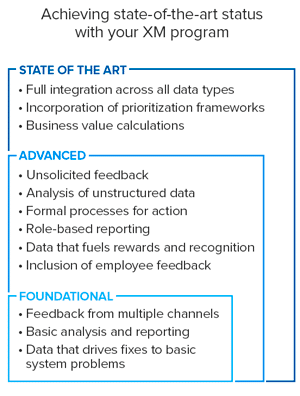What Is Customer Experience Management?
Published on Feb 18, 2022

Ready to invest in the customer experience?
Wise move.
After all, your customers have the answers—and they’ll tell you the truth if you ask the right questions and take the right actions.
But making an investment is one thing—making sure it pays off is another. Whether you’re launching your first customer experience management (CEM) program or hitting refresh, when you partner with the right CEM provider, you can transition almost seamlessly into a program that engages all levels of your organization—from the field teams to the c-suite. And suddenly, those challenges start to transform into opportunities for your customer experience program to gain traction and drive real change.
But choosing the right experience management partner (or evaluating your current experience program) can be overwhelming. To help guide your vetting efforts, we’ve created a detailed list containing the ins and outs of a successful customer experience management strategy.
Reference these FAQs to answer “What is customer experience management” and create a program that works best for you and your internal stakeholders—ultimately driving closer, more valuable relationships with your customers.
What does customer experience management mean?
Gartner® defines customer experience management as “the discipline of understanding customers and deploying strategic plans that enable cross-functional efforts and customer-centric culture to improve satisfaction, loyalty and advocacy.”
When this discipline is put into action, brands have access to actionable customer data that drives business performance at the location and brand level. But when it comes to selecting a customer experience partner, remember a technology platform only gets you part of the way there. The addition of partnership, service, and operator support gets you all the way there.
This collaborative approach will help you overcome common program pitfalls, including:
- The experience management (XM) program becoming siloed in one department
- Program owners being protective over decisions about the customer experience (CX)
- Departments not having clear ownership or understanding of how they impact CX
- Lack of buy-in among executives, resulting in loss of trust in the customer voice at all levels
- Defensive culture that would rather make excuses for negative feedback rather than make improvements
- Overly ambitious action plans that result in a lack of focus
Ultimately, your goal is to build an experience management program that delivers maximum business impact. To achieve this program maturity, your XM partner should work with you to create a phased approach with tactical prioritization dedicated to the continual advancement of your program.

How can customer experience management drive financial performance?
At the end of the day, experience management programs are successful when they’re easily interpreted, inspire action, and lead to meaningful outcomes that link to financials.
The most obvious business outcome is higher comp sales. For locations and channels to drive sales growth, they first need to improve on key drivers, which leads to improvements in Overall Satisfaction/NPS and links to increased loyalty and sales growth.
But ROI doesn’t end at comp sales. There are all kinds of ways to prove the changes you’re making are having an impact, such as lower employee turnover, shorter return cycles, and higher social ratings.
Data isn’t enough, and companies can’t win loyalty by simply measuring the customer experience. To really make an impact, they have to connect customer experience data to meaningful action by uncovering true insight—because that’s what leads to business outcomes.
To help you evaluate your current experience management strategy and ensure it’s delivering insights (and not just collecting data), here are some key functions of an insights-driven XM program:
Collect feedback across touchpoints | To get a holistic view of the customer experience, you need an enterprise measurement strategy that collects location-level feedback across the entire customer journey. By analyzing both solicited and unsolicited data—across all touchpoints—you can truly understand the full scope of how customers interact with your brand and create an action plan focused on making targeted improvements.
Provide an intuitive technology platform | Great data doesn’t matter if it doesn’t make sense. Without a clear way to spot trends, compare scores, and read comments, it can feel impossible to take action. With a customer experience management platform that streamlines real-time data and provides easy-to-read visualizations, you’ll have access to tools like role-based reporting, customizable dashboards, industry benchmarks, and AI-native text analytics. By getting the data you need, when and how you need it, you can really understand what consumers are trying to tell you—making it easier to drive meaningful change across your organization.
Offer professional support | A robust and intuitive reporting platform is a vital component of your experience management program, but technology alone will only get you so far. In order to turn mountains of data into actionable insights, you’ll want a dedicated professional services team that provides analysis support, insight delivery, and ongoing strategic partnership. A collaborative tech and professional services approach is most successful in producing measurable results that boost loyalty and drive business performance.
Demonstrate ROI | It’s tough to justify the value of an experience management program when it doesn’t improve business outcomes. You need a provider that surfaces actionable insights and produces tangible results—helping you map CX improvements to cross-functional gains so you can prove the program is worth the effort.
How do I garner excitement and engagement throughout the organization about our customer experience management program?
A best-in-class experience management program has to deliver cutting-edge technology and world-class insights—but technology and insights will have diminished impact if field teams aren’t using the program to drive action. The truth is, the success of any experience management program depends largely on your field teams:
- Committing to your program + vision
- Delivering loyalty-inspiring customer service
- Using reporting tools frequently + effectively
That’s why it’s so critical to choose an experience management partner with a proven track record of keeping the field engaged and schedule regular program checkups once your strategy is in place. Because left unaddressed, a disengaged field can lead to more serious conditions detrimental to your brand’s long-term health—including decreased customer loyalty, loss of competitive visit share, and eventually lower comp sales.
Here are some ways to keep field teams engaged:
Break down company walls to maximize engagement | When programs get siloed, engagement gets stifled. Make sure your program has visibility in every department, at every level. Some best practices include:
- Sending program communications addressed personally from executive stakeholders
- Putting a spotlight on CX insights at company conferences and training sessions
- Celebrating program wins as an organization—visibly + consistently
Pair CX data with familiar metrics to showcase accuracy + impact | Don’t let your program live in the abstract. Measure and communicate the ways it impacts your most tangible business metrics. Here are some ways to create and track objective impact:
- Simplify your top-down messaging to identify the biggest opportunities
- Confirm key drivers with operational audits + field observations
- Bolster your data with qualitative insights from real-time customer comments
Tailor CX reporting tools to specific roles | When it comes to the customer experience, there are no small roles—focus on getting everyone on board and in tune with your strategy. To explain how the CX program fits into the organization’s overarching strategy, use things like:
- Executive communications to reiterate top-line visibility
- Regular training webinars to keep everyone fresh on best practices
- Push reports to follow through and keep the program top of mind
Get an actionable sample to guide your focus | To keep the needle moving, you have to keep the data coming. Do everything you can to turn up the volume on customer feedback. To ensure each location is getting a sufficient sample:
- Create store signage and remind the front line to inform customers about the survey
- Use multiple invitation methods to get a broader, more representative sample
- Drive up response rates and return visits simultaneously by using bounce-back incentives
Use multiple forums to share + message consistently | When you’re charting a path to improvement, you can’t afford to be all over the map. Be selective and communicate with purpose. To make sure you’re getting the right information to the right people:
- Task your CX partner with focusing analysis presentations on the most actionable items
- Enlist a steering committee to share those insights quickly and broadly
- Make sure mid managers focus coaching visits on how to improve key drivers
Keep the program front + center at every location | A CX program that falls off the radar is at risk of falling off the rails. Keep your unit-level insights and action plans top-of-mind at every location. Start initiatives like:
- Shift huddles to review role-specific, prescriptive actions
- Breakroom scoreboards to set goals and track progress
- Service alerts to track and resolve specific business issues
Recognize employees for their achievements | When you’re trying to keep employees engaged, don’t just reward them—create a workplace that makes work rewarding. There are several ways you can track and celebrate program wins, including:
- Using celebration alerts when customers recognize an employee for exceptional service
- Sending monthly communications from executives to call out top performers
- Incentivizing continuous improvement by rewarding teams who achieve the goals you set
Field engagement can be a tricky thing to address, partly because it’s so hard to quantify. But it’s a critical discussion every customer experience program needs to have regularly and proactively. Chances are, by the time you’ve diagnosed it as a problem, it’s already become a widespread issue.
The best thing you can do to spark and sustain engagement is choose an experience management partner that knows how to get the right information to the right people at the right time.
Boost loyalty and drive business outcomes with the right customer experience management partner
Success (and survival) rely on being future-focused; history tells us it’s simply not enough to maintain. Brands must steadily seek ways to attract more customers, open more channels, and offer better products and services.
It’s about uncovering new ways of doing business that open new streams of revenue. Consumer feedback makes it possible—providing necessary perspective on what works, what doesn’t, and what you must do to move your brand forward.
By investing in the customer experience, you’ve already made one good choice—so why stop there?
Since 1991, SMG has helped hundreds of the world’s top brands launch customer experience programs that continue to drive their business in the right direction.
Sure, it takes focus and effort—there are a lot of best practices to consider and pitfalls to avoid. But when you partner with a company that’s been there before—with hundreds of brands facing unique challenges—you can rest assured the work is worth it.
Need more convincing? Read the ebook, How to prove the business impact of your CX program, for ways to build and sustain an ROI-generating customer experience management strategy.
Related articles

5 tech capabilities experience management programs need to support complex enterprises
While most brands understand the importance of customer + employee feedback and have some sort of experience management (XM) solution in place, many lack the actionable insights necessary to create me

Automotive Reputation Management: A Quick-Start Guide on Navigating Online Reviews
With the right automotive reputation management, your brand can optimize online ratings and reviews to drive engagement and brand advocacy. Here's how:

The economic impact of a customer experience management program on your business: How to potentially develop 550% ROI in 3 years or less
An experience management (XM) program can drive changes across your business that increase loyalty, reduce churn, and generate revenue—and even the